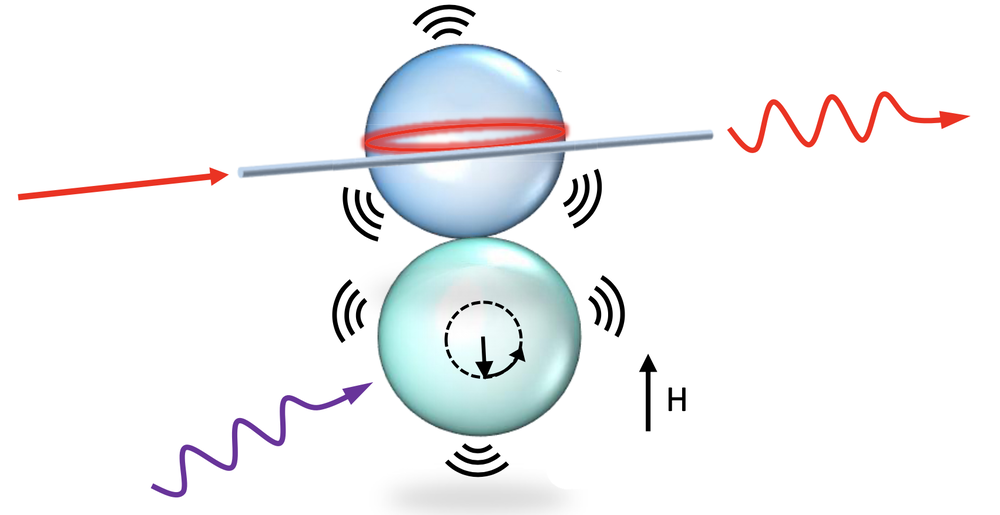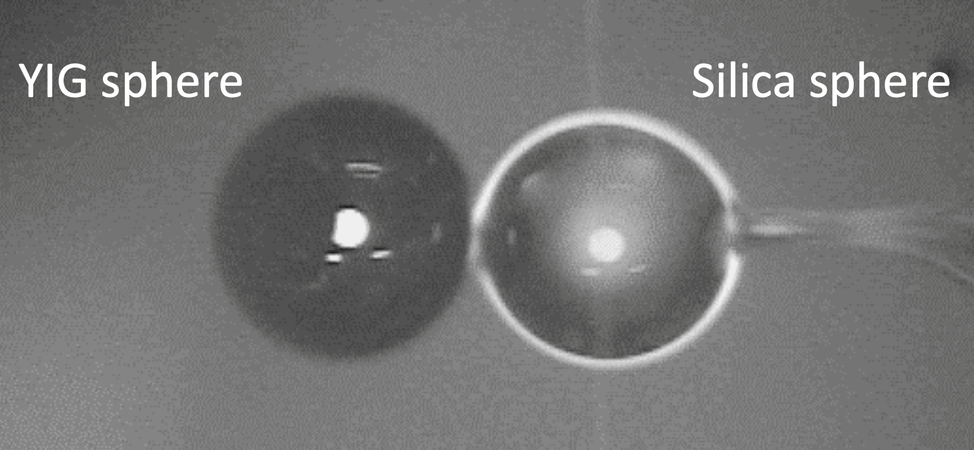Microsphere Pair Converts Microwaves to Light
Future quantum communication systems will likely use microwaves to transfer information into and out of storage and processing devices but will use lasers to carry information from point to point within an extended network. Now researchers have demonstrated an improved method for converting microwaves to visible light signals by exploiting the way that electromagnetic waves can set up vibrations within microspheres [1]. Two microspheres in contact—one sensitive to microwaves and the other sensitive to optical signals—serve as the core of the converter. The work should give researchers a wider range of technological options as they develop advanced communications and computing networks.
Researchers are pursuing a variety of ways to store quantum information, or “qubits,” in microscopic, typically superconducting, structures. One common feature of such technologies is that reading or writing information relies on interactions with microwaves rather than on higher-frequency visible or infrared light from lasers. But lasers offer the best way to move information around, so extended networks of such devices will need ways to convert signals from one form to the other.
Currently, these conversions can be achieved using optomechanical devices that manipulate the behavior of light in nanoscale mechanical structures. However, a significant problem with such systems is a lack of tunability, meaning that they can only convert microwaves in a small range of frequencies, says Chun-Hua Dong of the University of Science and Technology of China. Now he and colleagues report a way to overcome this problem by exploiting the tendency for both optical and microwave signals to induce mechanical oscillations (vibrations) in microscopic spheres of appropriate materials.
To demonstrate the conversion effect, Dong and colleagues directed a laser beam through an optical fiber touching a 200-micrometer-diameter silica microsphere. Inside this microsphere, radiation pressure from the small fraction of light that was absorbed set up vibrations at two distinct frequencies, each corresponding to a natural vibrational mode of the sphere. Meanwhile, the researchers placed a second microsphere made from a magnetic material in physical contact with the first microsphere. In the presence of a magnetic field, microwaves directed at this microsphere generate oscillations in the magnetic moment of the sphere known as magnons. These, in turn, excite vibrations.
In order to boost the vibration amplitude of the magnetic sphere, the team hit it with a second microwave source. The difference between the two microwave frequencies was equal to the vibration frequency, a situation that enhances a useful process: incoming photons from the higher-frequency source give up a bit of energy in the form of vibrations (phonons) and are left with the energy of the lower-frequency photons.
Using the microwave sources, the team set up vibrations in the magnetic sphere that affected the vibrations of the optical sphere and ultimately controlled the amplitude and phase of the optical light emerging from it. This experiment demonstrated conversion of the microwave signal into an optical signal, and the researchers expect that a similar setup should allow conversion in the opposite direction.
As Dong emphasizes, a key advantage of this technique over earlier conversion technologies is the ease with which the device can switch among a wide range of microwave frequencies. The operating frequency can be adjusted by simply changing the strength of the applied magnetic field. The researchers converted microwave signals with frequencies ranging from 4 to 7 GHz, a far wider range than earlier techniques allow.
“The main motivation of our work is to achieve the interconversion between stationary qubits in superconducting circuits and ‘flying’ qubits carried by photons in optical fibers,” says Dong. Different stationary qubit designs may require different microwave frequencies, and things could get complicated if each one needed its own dedicated converter. “One application we envision is a single device able to convert signals for multiple superconducting qubits with different frequencies,” he says.
“Good ways to transfer quantum information between microwave and optical modes are urgently needed for building quantum networks,” says quantum systems engineer Liang Jiang of the University of Chicago. “Recently there’s been lots of exciting research advances in this area, and this work demonstrates another interesting and potentially useful technique.”
–Mark Buchanan
Mark Buchanan is a freelance science writer who splits his time between Abergavenny, UK, and Notre Dame de Courson, France.
References
- Z. Shen et al., “Coherent coupling between phonons, magnons, and photons,” Phys. Rev. Lett. 129, 243601 (2022).







